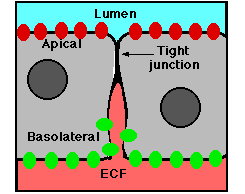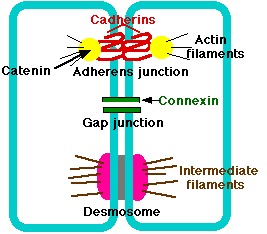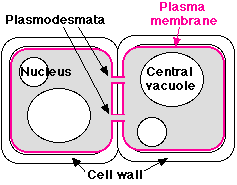Junctions Between Cells
In many animal tissues (e.g., connective tissue), each cell is separated from the next by an extracellular coating or matrix.
However, in some tissues (e.g., epithelia), the plasma membranes of adjacent cells are pressed together. Four kinds of junctions occur in vertebrates:
In many plant tissues, it turns out that the plasma membrane of each cell is continuous with that of the adjacent cells. The membranes contact each other through openings in the cell wall called
Epithelia are sheets of cells that provide the interface between masses of cells and a cavity or space (a lumen).
- The portion of the cell exposed to the lumen is called its apical surface.
- The rest of the cell (i.e., its sides and base) make up the basolateral surface.

Tight junctions seal adjacent epithelial cells in a narrow band just beneath their apical surface.
Tight junctions perform two vital functions:
- They prevent the passage of molecules and ions through the space between cells. So materials must actually enter the cells (by diffusion or active transport) in order to pass through the tissue. This pathway provides control over what substances are allowed through.
- They block the movement of integral membrane proteins (red and green ovals) between the apical and basolateral surfaces of the cell. Thus the special functions of each surface, for example
can be preserved.
Adherens junctions provide strong mechanical attachments between adjacent cells.
- They hold cardiac muscle cells tightly together as the heart expands and contracts.
- They hold epithelial cells together.
- They seem to be responsible for contact inhibition.
- Some adherens junctions are present in narrow bands connecting adjacent cells.
- Others are present in discrete patches holding the cells together.
 Adherens junctions are built from:
Adherens junctions are built from:
- cadherins - transmembrane proteins (shown in red) whose
- extracellular segments bind to each other and
- whose intracellular segments bind to
- catenins (yellow). Catenins are connected to
actin microfilaments
One of the oncogenes that is frequently found in colon cancer appears to be the mutated version of a protein that normally interacts with catenins. Loss of functioning adherens junctions may also lead to tumor metastasis.
Gap Junctions
Gap junctions are intercellular channels some 1.5 - 2 nm in diameter. These permit the free passage between the cells of ions and small molecules (up to a molecular weight of about 1000 daltons).
They are constructed from 4 (sometimes 6) copies of one of a family of a transmembrane proteins called connexins.
Because ions can flow through them, gap junctions permit changes in membrane potential to pass from cell to cell.
Examples:
- The action potential in heart (cardiac) muscle flows from cell to cell through the heart providing the rhythmic contraction of the heartbeat.
- At the few electrical synapses in the brain, gap junctions permit the arrival of an action potential at the synaptic terminals to be transmitted to the postsynaptic cell without the delay needed for release of a neurotransmitter.
- As the time of birth approaches, gap junctions between the smooth muscle cells of the uterus enable coordinated, powerful contractions to begin.
Several inherited disorders of humans such as
- certain congenital heart defects and
- one form of congenital deafness
have been found to be caused by mutant genes encoding connexins.
Desmosomes are localized patches that hold two cells tightly together. They are common in epithelia (e.g., the skin). Desmosomes are associated with intermediate filaments in the cytoplasm.
Carcinomas are cancers of epithelia. However, the cells of carcinomas no longer have desmosomes. This may account for their ability to metastasize.

Although each plant cell is encased in a boxlike cell wall, it turns out that communication between cells is just as easy, if not easier, than between animal cells. Fine strands of cytoplasm, called plasmodesmata, extend through pores in the cell wall connecting the cytoplasm of each cell with that of its neighbors.
Plasmodesmata provide an easy route for the movement of ions, small molecules like sugars and amino acids, and even macromolecules like RNA between cells.
A report in the 6 March 1998 issue of Science (Jorgensen et al., p. 1486) describes how plasmodesmata enable plants to transmit signals - such as the need to mount a defense against a viral infection - from one part of the plant to another.
Plasmodesmata are sheathed by a plasma membrane that is simply an extension of the plasma membrane of the adjoining cells. This raises the intriguing question of whether a plant tissue is really made up of separate cells or is, instead, a syncytium: a single, multinucleated cell distributed throughout hundreds of tiny compartments!
8 June 1999

 Adherens junctions are built from:
Adherens junctions are built from:
